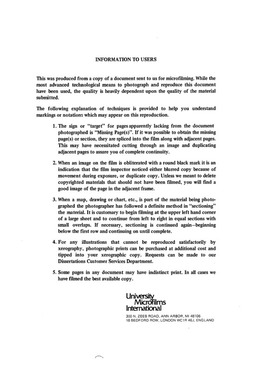| dc.contributor.author | Hodges, Daniel Houston, | en_US |
| dc.date.accessioned | 2013-08-16T12:28:17Z | |
| dc.date.available | 2013-08-16T12:28:17Z | |
| dc.date.issued | 1980 | en_US |
| dc.identifier.uri | https://hdl.handle.net/11244/4820 | |
| dc.description.abstract | The songs were transcribed into traditional European musical notation, supplemented by additional symbols to indicate sounds that do not lend themselves to traditional notation. The system of symbols was adapted from similar systems used by several earlier researchers of Indian music. A few symbols were devised by the writer of this study. | en_US |
| dc.description.abstract | The writer collected and examined recordings of 130 songs, ninety percent of which were recorded within the past decade. The recordings were from the following sources: (1) Songs recorded by the writer in Cheyenne homes; (2) Disc recordings and cassette tapes lent by a Southern Cheyenne acquaintance; (3) Recordings produced by Southern Cheyennes at Fay, Oklahoma; (4) Commercial recordings produced by Canyon Records and Indian House Records; (5) Songs recorded from live performances on WNAD (then the University of Oklahoma radio station) in the late 1940's. | en_US |
| dc.description.abstract | Style characteristics were determined in the following categories: (1) range, (2) scales, (3) cadence pitches, (4) melodic contours, (5) frequency of intervals, (6) meter, (7) tempo, (8) performance time, and (9) form. An analysis sheet following each transcription lists the relevant data. The characteristics for each category of songs are summarized. | en_US |
| dc.description.abstract | The purpose of the study was to examine a large number of Southern Cheyenne songs and to select from these a representative group of songs of various types to be transcribed and analyzed. This is the first study to deal exclusively with songs of the Cheyennes living in Oklahoma (the Northern Cheyennes are located in Montana). | en_US |
| dc.description.abstract | A discussion of procedures of transcription and analysis precedes the six chapters containing the songs and the summaries of their characteristics. The last two chapters give summaries for all of the songs, comparisons with earlier studies, and conclusions. | en_US |
| dc.description.abstract | Sixty songs, representing more than thirty Southern Cheyenne singers, were transcribed and analyzed. The songs were divided into six categories, based on the function that the songs serve within the Cheyenne culture. The categories are (1) war-related songs, (2) wolf songs, (3) Sun Dance songs, (4) social dance songs, (5) peyote songs, and (6) miscellaneous songs. | en_US |
| dc.description.abstract | From the resulting analyses, answers to the following questions were sought. (1) Do the songs of the present day show the same characteristics as those identified in earlier studies? (2) What are the differences, if any? (3) What do any differences tell about change in the Southern Cheyenne musical culture? Is the present day American musical culture being absorbed into the traditional Cheyenne musical culture? | en_US |
| dc.description.abstract | The writer concluded that differences in the songs found between this study and earlier studies were differences of degree more than of substance. The most obvious differences involved range and meter. From the evaluation of the data it was concluded that the Southern Cheyennes have maintained the integrity of their musical tradition in the performance of songs from the earlier part of this century to the present day. Their musical culture remains basically untouched by the extremely diverse American musical culture. | en_US |
| dc.description.abstract | Related literature is surveyed in the second chapter, divided into three groups: (1) studies of Cheyenne music, (2) studies of Cheyenne history and culture, and (3) selected studies of American Indian music. The third chapter sketches Southern Cheyenne history. The following chapters survey Cheyenne musical instruments and style characteristics of Cheyenne song. | en_US |
| dc.description.abstract | Fifty-nine of the songs, to the extent that can be determined, were transcribed for the first time. One of the songs was the same as one transcribed by Frances Densmore in 1935. | en_US |
| dc.format.extent | vii, 260 leaves : | en_US |
| dc.subject | Education, Music. | en_US |
| dc.title | Transcription and analysis of Southern Cheyenne songs. | en_US |
| dc.type | Thesis | en_US |
| dc.thesis.degree | Ph.D. | en_US |
| dc.thesis.degreeDiscipline | School of Music | en_US |
| dc.note | Source: Dissertation Abstracts International, Volume: 41-10, Section: A, page: 4322. | en_US |
| ou.identifier | (UMI)AAI8107958 | en_US |
| ou.group | Weitzenhoffer Family College of Fine Arts::School of Music | |
